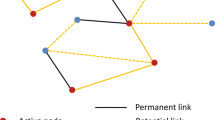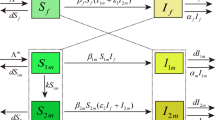Abstract
The classical models for sexually transmitted infections assume homogeneous mixing either between all males and females or between certain subgroups of males and females with heterogeneous contact rates. This implies that everybody is all the time at risk of acquiring an infection. These models ignore the fact that the formation of a pair of two susceptibles renders them in a sense temporarily immune to infection as long as the partners do not separate and have no contacts with other partners. The present paper takes into account the phenomenon of pair formation by introducing explicitly a pairing rate and a separation rate. The infection transmission dynamics depends on the contact rate within a pair and the duration of a partnership. It turns out that endemic equilibria can only exist if the separation rate is sufficiently large in order to ensure the necessary number of sexual partners. The classical models are recovered if one lets the separation rate tend to infinity.
Similar content being viewed by others
References
Anderson, R. M., Medley, G. F., May, R. M., Johnson, A. M.: A preliminary study of the transmission dynamics of the Human Immunodeficiency Virus (HIV), the causative agent of AIDS. IMA J. Math. Appl. Med. Biol. 3, 229–263 (1986)
Bailey, N. T. J.: Introduction to the modeling of sexual disease. J. Math. Biol. 8, 301–322 (1979)
Bailey, N. T. J., Estreicher, J.: Epidemic prediction and public health control, with special reference to influenza and AIDS, Proc. First World Congress Bernoulli Soc., Tashkent 1986, VNU Science Press, Utrecht, to appear (1987)
Dietz, K.: Mathematical models for the control of malaria. In: Wernsdorfer W. H., MacGregor J.A., (eds.) Malaria, chap. 37, pp. 1087–1129. Edinburgh: Churchill Livingstone 1987a
Dietz, K.: Epidemiological models for sexually transmitted infections. Proc. First World Congress Bernoulli Soc., Tashkent 1986, VNU Science Press, Utrecht, to appear (1987b)
Dietz, K., Renner, H.: A simulation model for the control of helminth diseases by chemotherapy. In: Capasso, V., Grosso, E., Paveri-Fontana, S. L. (eds.) Mathematics in Biology and Medicine, Proceedings, Bari 1983. (Lect. Notes Biomath., vol. 57, pp. 115–126) Berlin, Heidelberg, New York: Springer 1985
Fredrickson, A. G.: A mathematical theory of age structure in sexual populations: random mating and monogamous marriage models. Math. Biosc. 10, 117–143 (1971)
Hadeler, K. P.: Dynamics of parasitic infections and of sexually transmitted diseases, In: Gross, L. J., Hallam, T. G., Levin, S. A. (eds.) Second Autumn Course on Mathematical Ecology Proceedings, Trieste 1986 to appear (1987)
Hadeler, K. P., Waldstätter, R., Wörz, A.: Models for pair formation. Conf. Proc. “Deutsch-Französisches Treffen über Evolutionsgleichungen and Positivität, Blaubeuren 1987”, Semesterbericht Funktionalanalysis Tübingen 1987
Hethcote, H. W., Tudor, D. W.: Integral equation models for endemic infectious diseases. J. Math. Biol. 9, 37–47 (1980)
Hethcote, H. W., Yorke, J.A.: Gonorrhea transmission dynamics and control. Lect. Notes Biomath., vol. 56. Berlin, Heidelberg, New York: Springer 1984
Kendall, D. G.: Stochastic processes and population growth, J.R. Statist. Soc. Ser. B. 11, 230–264 (1949)
Keyfitz, N.: The mathematics of sex and marriage. Proceedings of the Sixth Berkeley Symposium on Mathematical Statistics and Probability, vol. IV: Biology and Health, 89–108 (1972)
Kießling, D., Stannat, S., Schedel, L, Deicher, H.: Überlegungen und Hochrechnungen zur Epidemiologie des “Acquired Immunodeficiency Syndrome” in der Bundesrepublik Deutschland. Infection 14, 217–222 (1986)
Knox, E. G.: A transmission model for AIDS. European J. Epidemiol. 1, 165–177 (1986)
Martini, E.: Betrachtungen zur Epidemiologie der Malaria und der Syphilis. Dermatologische Wochenschrift 19, 640–643 (1928)
McFarland, D. D.: Comparison of alternative marriage models. In: Greville, T. N. E. (ed.) Population dynamics, pp. 80–106. New York, London: Academic Press 1972
McKendrick, A. G., On certain mathematical aspects of malaria. Proceedings of the Imperial Malaria Committee, Bombay, 16–17 Nov. 1911, pp 54–66 (1912)
Nåsell, I.: Hybrid models of tropical infections. Lect. Notes Biomath., vol. 59. Berlin, Heidelberg, New York: Springer 1985
Parlett, B.: Can there be a marriage function? In: Greville T. N. E. (ed.) Population dynamics, New York, London: Academic Press 1972
Peterman, T. A., Stoneburner, R. L., Allen, J. R., Jaffe, H. W., Curran, J. W.: Risk of HIV transmission from heterosexual adults with transfusion associated infections. J. Am. Med. Ass., to appear (1987)
Pollard, J. H.: Mathematical models for the growth of human populations chap. 7. Cambridge: The University Press 1973
Ross, R.: The prevention of malaria, 2nd edn. Murray: London 1911
Staroverov, O. V.: Reproduction of the structure of the population and of marriages (in Russian). Ekonomika i matematičeskije metody 13, 72–82 (1977)
Author information
Authors and Affiliations
Additional information
This work has been supported by Deutsche Forschungsgemeinschaft
Rights and permissions
About this article
Cite this article
Dietz, K., Hadeler, K.P. Epidemiological models for sexually transmitted diseases. J. Math. Biology 26, 1–25 (1988). https://doi.org/10.1007/BF00280169
Received:
Revised:
Issue Date:
DOI: https://doi.org/10.1007/BF00280169




